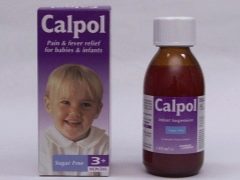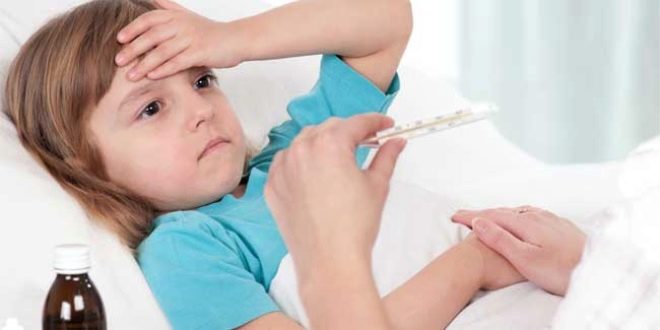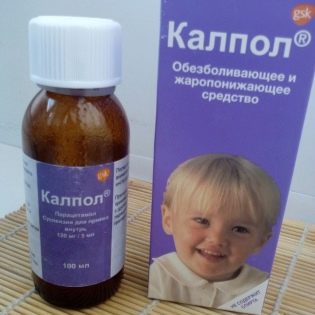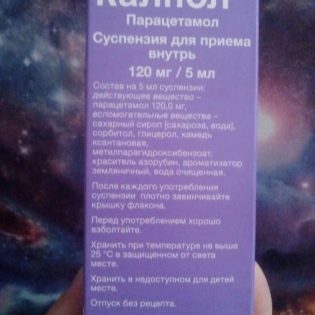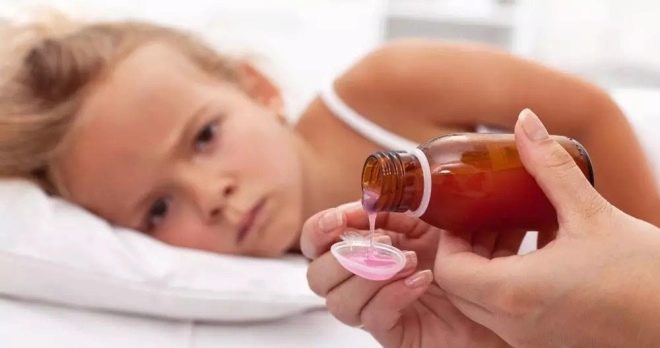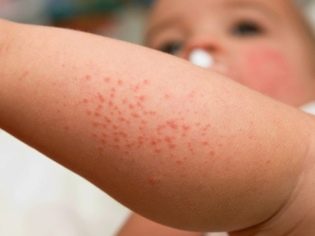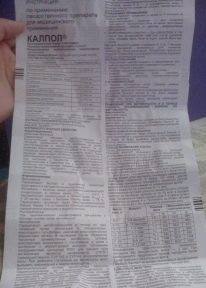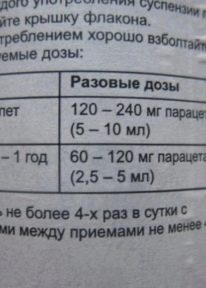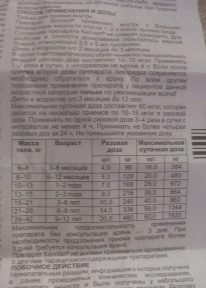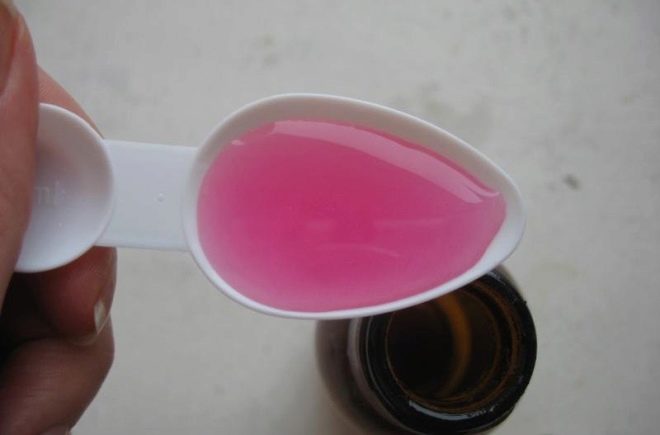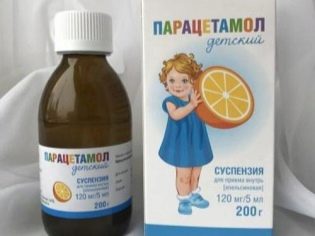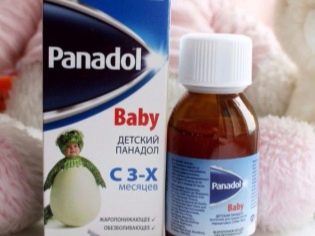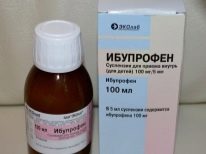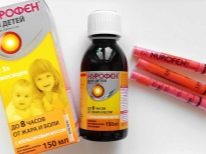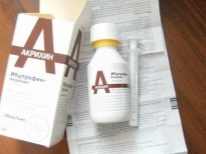"Kalpol" for children: instructions for use
If a young child has a fever or pain, most often resort to drugs that contain paracetamol, because they are relatively safe for kids and effectively cope with both fever and painful sensations.
One of the preparations with such an active substance is “Kalpol”. It is presented as a convenient for children liquid form and is easily dosed, however, it has some drawbacks, and its use in babies requires compliance with certain conditions.
Release form and composition
“Kalpol” is produced in Germany by the famous company GlaxoSmithKline only in one form. This is a sweet strawberry suspension, which has a pink tint. Usually the drug is homogeneous, but when shaken, foam bubbles sometimes appear on its surface. Suspension is sold in a glass bottle that holds 70 or 100 ml of the drug. In the form of tablets, syrup, drops, gel, capsules or other forms of "Kalpol" does not happen.
The active ingredient of the drug, as already noted, is paracetamol. Its content in 5 milliliters of suspension is 120 mg. So that the medicine was sweet, and the children liked its taste, they included sugar syrup and strawberry flavor. In addition, Kalpol contains xanthan gum, a dye, glycerol, methyl parahydroxybenzoate, purified water and sorbitol.
Operating principle
Paracetamol has the ability to influence the formation of prostaglandins, due to which such a substance causes antipyretic and analgesic effects. The medication taken orally is absorbed fairly quickly, ensuring the maximum level of paracetamol in the blood 0.5–1.5 hours after ingestion. Metabolic changes of the active substance "Kalpol" occur in the liver, so the diseases of this organ can affect the effect of the drug.
Most of the paracetamol leaves the child’s body with urine within 24 hours after applying the suspension.
Indications
The predominant reason for prescribing Kalpol to children is an increased body temperature, which is a symptom of influenza, a childhood infection (scarlet fever, measles, mumps, rubella and others), ARVI, vaccination reactions, and so on.
Suspension is also given to babies with moderate or mild pain, for example, if the crumb is injured, the child is teething or has a headache.
At what age is prescribed?
“Kalpol” is recommended for small patients from three months to six years of age.
This suspension is contraindicated in newborn babies, and in babies 1-3 months can only be used as directed by the pediatrician.
Children older than 6 years, the drug is usually not prescribed, since they require higher dosages of paracetamol, and it is inconvenient to drink a lot of suspension.
Contraindications
“Kalpol” is strictly prohibited in case of hypersensitivity to paracetamol or any inactive component of the solution. The drug is also not prescribed for blood diseases, severe kidney disease and impaired liver function.
Another contraindication for receiving such a suspension, as well as its analogues in the active substance, is the lack of an enzyme in the body, which is called “glucose-6-phosphate dehydrogenase”.
Side effects
Since "Kalpol" practically does not affect prostaglandins, which are synthesized outside the brain, the intake of the suspension does not affect the water-salt metabolism, and also does not damage the gastrointestinal mucosa. However, occasionally the medication can cause such negative side effects as allergic skin rash, nausea and others.
Too long use of the drug adversely affects the liver, blood picture and kidney function.
How to use?
The drug is dosed with a spoon, which is in the box with the bottle. On the one hand, it is smaller and holds 2.5 ml of the suspension, and on the other hand the spoon is slightly larger and allows you to measure 5 ml of medication. Typing "Kalpol", the drug is given to swallow the baby right from the spoon. It is not necessary to dilute the suspension with water, but if necessary, you can give your child a drink of the drug, offering clean water. The optimal time of taking the drug is called 1-2 hours after a meal.
According to the instructions for use, a baby up to one year is usually enough 2.5 ml of “Kalpol”, but sometimes a single dose is increased to 5 ml. Dosage medication for patients 1-6 years is 5-10 ml. Suspension is given as needed when the temperature is much higher than normal, usually the antipyretic drug is recommended to be used at an indicator of more than 38.5 degrees, as well as if the child complains of pain.
If required, the drug can be taken repeatedly, but not earlier than 4 hours after the previous dose, and not more than 4 times in one day.
In this case, the duration of admission to reduce the temperature should not exceed three days, and in case of pain syndrome “Kalpol”, a maximum of 5 days can be given. When a fever or pain persists after a specified number of days, you should consult a doctor so that he can give Calpol further (with longer treatment, the child must undergo blood tests) or change the drug for another remedy (if the cause of the fever or pain is different).
Overdose
If the child accidentally drinks more "Kalpol" than is allowed at his age, it will cause nausea, pallor, abdominal pain and other negative symptoms. When they appear, you should immediately call a doctor, give the child an enterosorbent and acetylcysteine (it is an antidote). With a significant overdose on the second or third day, symptoms of liver damage appear, which in severe cases leads to encephalopathy and coma.
Drug interaction
Calpol should not be given to children along with any other paracetamol-based drugs, as this will increase the risk of side effects and overdose. In addition, the suspension should not be combined with many other drugs, for example, with anticonvulsants, anticoagulants or barbiturates.
If the child is taking any drugs, then it is better to check their compatibility with Kalpol with the attending physician.
Terms of sale and storage
Calpol, like other paracetamol-based drugs, is a non-prescription drug. The average cost of one bottle of suspension is 90-100 rubles.
It is recommended to keep the medicine at home at a temperature not higher than +25 degrees, putting the bottle in the place hidden from the kids. Shelf life funds - 3 years.
Reviews
On the use of "Kalpola" in childhood you can find a lot of good reviews. According to moms, the suspension quickly lowers the temperature and relieves pain, so it is often kept at home just in case or taken on trips with them, for example, included in a first aid kit for traveling to the Turkish or Egyptian coast.
The advantages of the drug include its liquid form, affordable price, long shelf life and pleasant taste. As for the minuses, many mothers mention the presence in the composition of sugar, dye and other chemical additives, which sometimes provoke an allergic reaction.
Analogs
If “Kalpol” was not available at the pharmacy, instead of it, you can purchase any other liquid medicine, the effect of which also provides paracetamol. Such a drug can be orange or strawberry suspension "Paracetamol", as well as suspension "Children's Panadol" with strawberry flavor. Any of these funds contains 120 mg of the active ingredient in 5 ml and is allowed from three months of age, and the indications and single dosages they also coincide.
In case of an allergic reaction to paracetamol, the doctor is likely to replace Calpol with one of the ibuprofen preparations, as they also belong to safe antipyretic and analgesic drugs for children. In the suspension, allowed for babies older than 3 months, release "Ibuprofen, Nurofen and Ibuprofen-Akrikhin.
Any of these medications will effectively lower the temperature as it rises and will eliminate the pain. In this case, the therapeutic effect of such drugs lasts a little longer than the effects of paracetamol. In addition, ibuprofen has a more pronounced anti-inflammatory effect, so these analogues are very popular with a strong inflammatory process, for example, if the crumb has otitis or bronchitis.
About what to do if the antipyretic did not help, learn in the next video.
